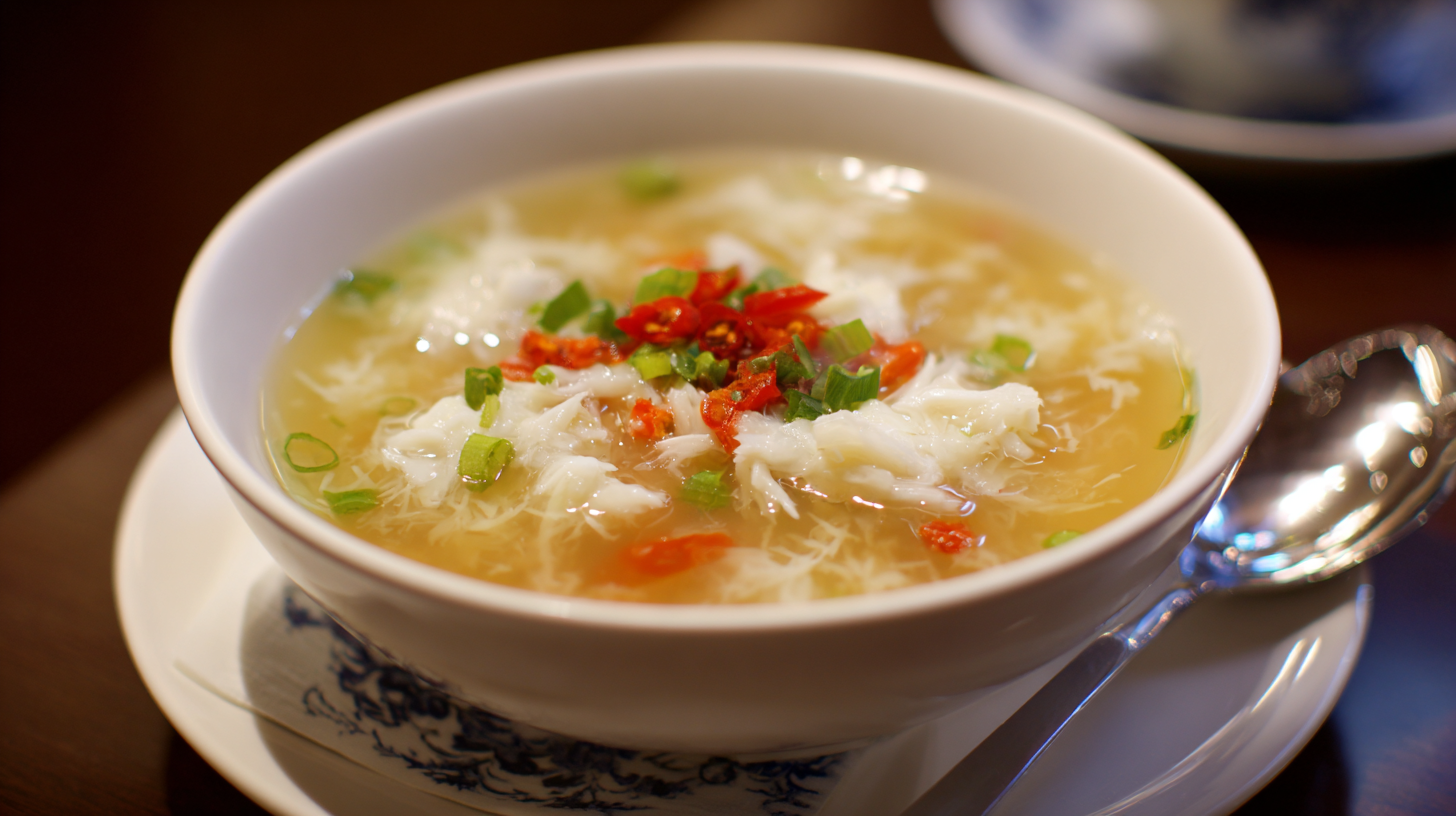Looking for a luxurious soup that combines delicate crab meat with the unique texture of fish maw? This Crab Meat Fish Maw Soup brings together two prized ingredients in Chinese cuisine for a dish that’s both nourishing and impressive.
This elegant soup has graced banquet tables across Asia for generations, known for its rich flavor and many health benefits. Fish maw—the dried swim bladder of large fish—brings a distinctive springy texture while absorbing the sweet essence of crab meat. You’ll love how this soup manages to be both light and satisfying, perfect as a starter for a special dinner or as a comforting meal on its own.
What Is Crab Meat Fish Maw Soup?
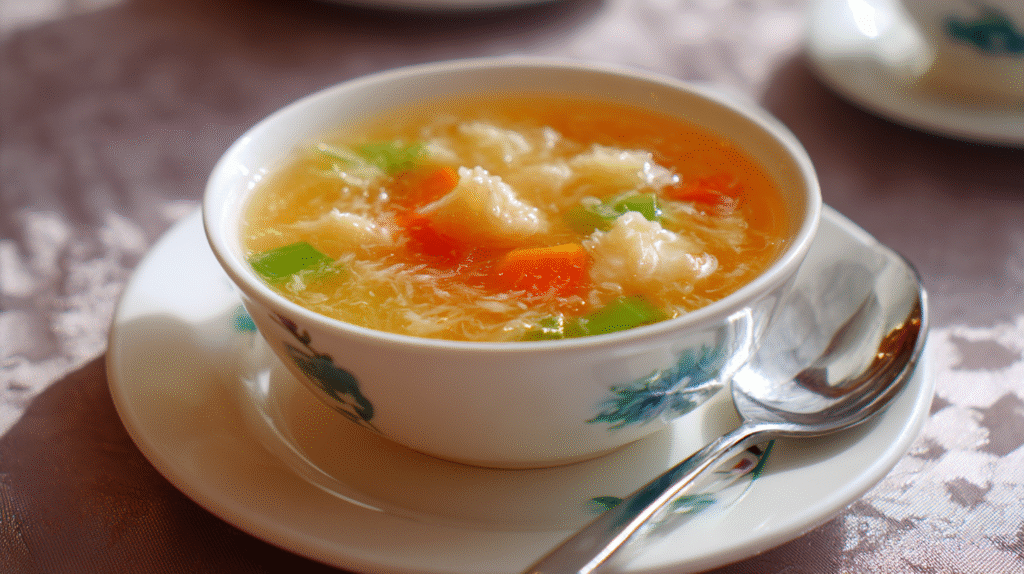
Crab meat fish maw soup represents a pinnacle of traditional Chinese cuisine that marries the sweet delicacy of fresh crab meat with the unique texture of rehydrated fish maw. This luxurious soup features a clear, golden broth that’s gently simmered to extract maximum flavor from premium ingredients.
Fish maw, the dried swim bladder of large fish, transforms into a spongy texture that absorbs the surrounding broth while providing a satisfying bite. When paired with tender chunks of crab meat, the combination creates a harmonious balance of seafood flavors and textures that’s both elegant and nourishing.
The soup typically includes other complementary ingredients such as fresh ginger, green onions and sometimes Chinese ham to enhance its complex flavor profile. Egg whites are often incorporated toward the end of cooking to create silky strands that float delicately throughout the broth.
This dish holds special significance in Chinese banquet cuisine where it’s served as a symbol of prosperity and abundance. The soup’s refined taste and nutritional benefits make it particularly popular during celebrations and special occasions throughout Hong Kong, Taiwan and mainland China.
Traditional Chinese medicine attributes various health benefits to fish maw including collagen support for skin health and joint function. The protein-rich combination with crab meat delivers a nutritional powerhouse that’s relatively light on calories yet deeply satisfying.
While preparation requires some specialized ingredients and technique, the resulting soup offers an authentic taste of Chinese fine dining that’s worth the effort. Each spoonful delivers a symphony of textures and flavors that exemplify why this soup has endured as a beloved classic for centuries.
Why You’ll Love This Traditional Chinese Delicacy

This crab meat fish maw soup delivers an unparalleled dining experience that will transport you straight to the finest restaurants in Hong Kong. Your taste buds will dance with the natural sweetness of fresh crab meat perfectly balanced by the unique texture of fish maw.
Health enthusiasts appreciate this soup for its impressive nutritional profile. Fish maw contains abundant collagen that supports skin elasticity and joint health. The protein-rich combination provides substantial nourishment without heaviness making it ideal for wellness-focused diets.
Serving this luxurious dish at your table instantly elevates any meal from ordinary to extraordinary. Guests will be impressed by your culinary prowess when you present this restaurant-quality delicacy at home. The golden broth creates a stunning visual presentation that promises exceptional flavor before the first spoonful.
Texture enthusiasts will marvel at the contrast between tender crab meat and the springy bite of rehydrated fish maw. Each spoonful offers multiple textural dimensions that keep your palate engaged throughout the meal. The silky egg white strands provide a delicate counterpoint to the hearty seafood components.
Seasonal versatility allows you to enjoy this soup year-round. Though traditionally served during celebrations and special occasions its comforting qualities make it welcome during cooler months while its light profile works beautifully in warmer seasons. The adaptable recipe accommodates preference adjustments without losing its authentic character.
Ingredients You’ll Need

Gathering the right ingredients is essential for creating an authentic crab meat fish maw soup with balanced flavors and proper texture. This luxurious soup requires several key components that work together to create its distinctive taste profile.
For The Soup Base
- 8 cups chicken stock (preferably homemade)
- 2 slices fresh ginger (¼-inch thick)
- 2 green onions (white parts only, lightly smashed)
- 2 tablespoons Shaoxing wine
- 1 teaspoon white pepper
- Salt to taste
- 1 tablespoon cornstarch (mixed with 2 tablespoons water for thickening)
For The Fish Maw
- 2 oz dried fish maw
- 4 cups water (for soaking)
- 1 tablespoon oil
- 1 teaspoon salt
For The Crab Meat
- 8 oz fresh lump crab meat (picked over for shells)
- 1 teaspoon sesame oil
- ½ teaspoon salt
- ¼ teaspoon white pepper
- 1 tablespoon Shaoxing wine
Additional Garnishes
- 2 egg whites (lightly beaten)
- 2 tablespoons cilantro (finely chopped)
- 1 green onion (finely sliced)
- 1 tablespoon ginger (julienned)
- 1 teaspoon white vinegar
- Few drops sesame oil
- Fresh ground white pepper
Kitchen Tools Required

Preparing crab meat fish maw soup requires exact equipment to achieve its luxurious texture and balanced flavors. Gather these essential tools before starting your culinary journey:
- Large soup pot – A heavy-bottomed pot (6-8 quart capacity) provides even heat distribution for simmering the delicate broth
- Medium-sized bowl – For soaking and rehydrating dried fish maw
- Fine mesh strainer – Essential for achieving the crystal-clear broth characteristic of high-quality Chinese soups
- Ladle – Preferably a ceramic or plastic soup ladle to avoid scratching your cookware
- Sharp knife – For slicing ginger and green onions precisely
- Cutting board – Separate boards for seafood and aromatics prevent cross-contamination
- Measuring cups and spoons – For accurate ingredient proportions
- Small bowls – To hold prepared ingredients ready for cooking (mise en place)
- Whisk – For beating egg whites to create silky strands in the soup
- Wooden spoon or silicone spatula – For gentle stirring that won’t break up delicate crab meat
- Soup tureen – An elegant serving vessel that keeps the soup hot at the table
- Soup spoons – Traditional Chinese porcelain spoons enhance the authentic dining experience
Your kitchen timer will also prove invaluable when monitoring the precise cooking times needed for this sophisticated soup. Quality equipment makes the preparation process smoother and helps you achieve restaurant-quality results at home.
Preparing The Fish Maw
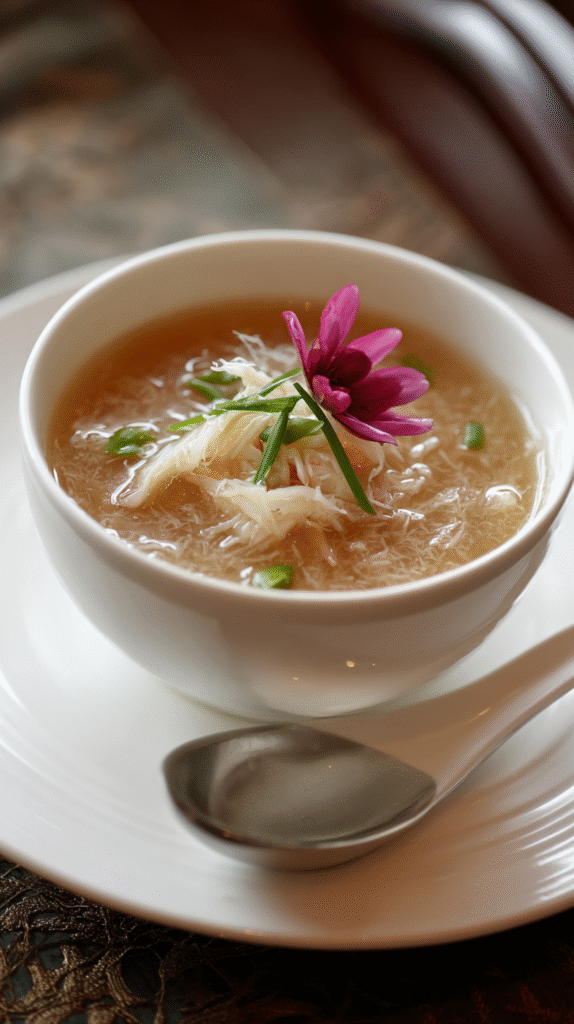
Fish maw requires careful preparation before it can shine in your soup. This dried delicacy transforms from a hard, brittle ingredient into a tender, gelatinous treasure with the right techniques.
Soaking Method
Start by examining your dried fish maw for any impurities or discoloration. Place the fish maw in a large bowl and cover completely with room temperature water. Allow it to soak for at least 4-6 hours, though overnight soaking yields the best results. You’ll notice the fish maw gradually expanding and softening as it absorbs the water. Replace the soaking water every 2 hours if possible to ensure cleanliness. The fish maw is properly rehydrated when it feels soft and pliable to the touch, expanding to about 3-4 times its original size. For premium quality fish maw, extend the soaking time to 8-10 hours to achieve the perfect springy texture that’s characteristic of an authentic crab meat fish maw soup.
Cleaning Process
After soaking, drain the fish maw completely in a colander. Rinse it thoroughly under cold running water, gently rubbing the surface to remove any remaining dirt or impurities. Inspect the rehydrated fish maw carefully and trim away any discolored portions or tough membranes using kitchen scissors. Cut the cleaned fish maw into bite-sized pieces approximately 1-inch square to ensure they’re easy to eat in the finished soup. Blanch the cut pieces in boiling water for 1-2 minutes to further clean and tenderize them. Transfer the blanched fish maw to an ice bath immediately to stop the cooking process and maintain its desired texture. This blanching step removes any lingering fishy odor and prepares the fish maw to absorb the delicate flavors of your soup broth. Pat the fish maw dry with paper towels before adding it to your soup preparation.
Making The Soup Base
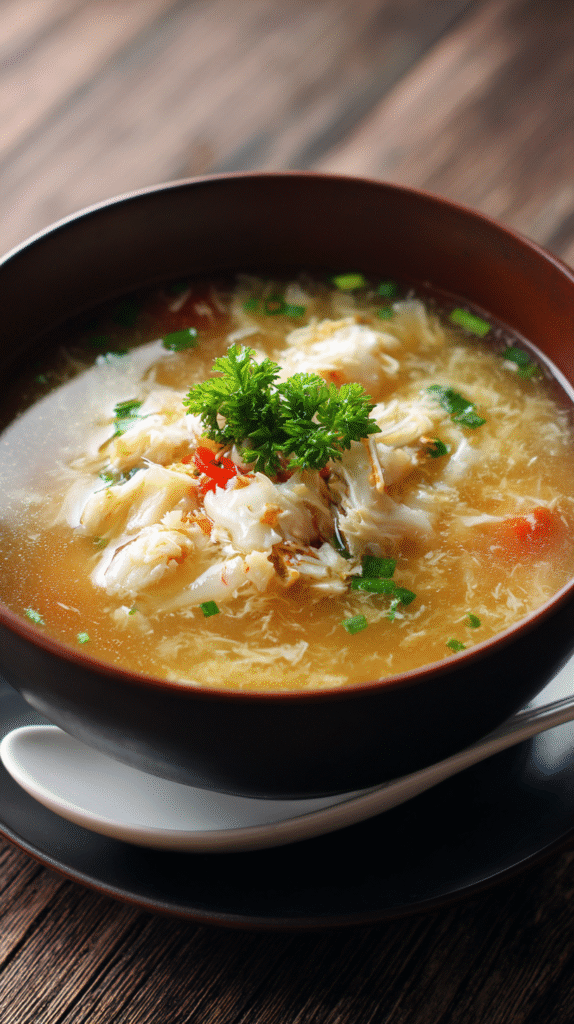
The foundation of any exceptional crab meat fish maw soup lies in its broth. A properly prepared soup base allows the delicate flavors of the premium ingredients to shine through while providing depth and richness.
Creating A Rich Broth
Start with high-quality chicken stock as your foundation—homemade yields the best results but a good-quality store-bought version works well too. Pour 8 cups of stock into a large pot and bring it to a gentle simmer over medium heat. Add 4-5 slices of fresh ginger and 2 stalks of green onions (white parts only) to infuse the broth with aromatic flavors. Splash in 2 tablespoons of Shaoxing wine to eliminate any potential fishiness and enhance the depth of flavor.
Allow this mixture to simmer uncovered for about 20 minutes to concentrate the flavors. The stock should reduce slightly and take on a golden hue with a fragrant aroma. Strain the broth through a fine-mesh sieve to achieve the crystal-clear consistency that’s characteristic of this premium soup. This clarity allows the beautiful ingredients to stand out visually when served.
Season the broth with 1 teaspoon of salt and ¼ teaspoon of white pepper. Taste and adjust the seasoning if necessary—the broth should taste well-rounded but not overpowering as the crab and fish maw will add their own natural flavors. Return the strained broth to the pot and keep it at a low simmer as you prepare to add the remaining ingredients.
For an even more luxurious version you can add a small piece of Chinese ham (Jinhua ham) or a handful of dried scallops to the initial simmering stage. These ingredients impart an umami richness that elevates the soup to restaurant quality. Remove these additions before straining if you choose to include them.
Cooking The Crab Meat Fish Maw Soup
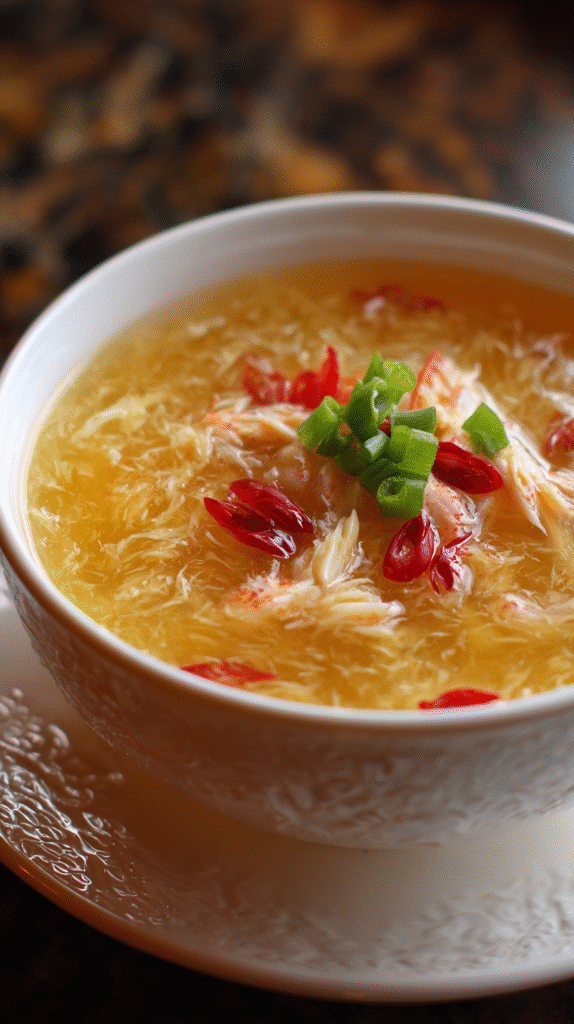
Now that your preparation is complete it’s time to bring all the elements together to create this luxurious soup. The cooking process requires attention to timing and temperature to preserve the delicate textures of both the fish maw and crab meat.
Adding The Fish Maw
Add your prepared fish maw to the simmering broth and adjust the heat to maintain a gentle simmer. Allow the fish maw to cook for approximately 15-20 minutes until it becomes tender yet still maintains its distinctive springy texture. During this cooking process the fish maw will absorb the rich flavors of your broth while contributing its unique gelatinous quality to the soup. Stir occasionally to ensure even cooking but avoid vigorous stirring which might break apart the delicate pieces. You’ll know the fish maw is properly cooked when it has a slight translucent appearance and offers just the right amount of resistance when bitten.
Incorporating The Crab Meat
Introduce the fresh lump crab meat to your soup about 5 minutes before serving. Gently fold the crab meat into the hot broth rather than stirring vigorously to preserve its delicate chunks. The goal is to warm the crab meat through without overcooking it which would toughen its texture and diminish its sweet flavor. Pour the beaten egg whites in a thin stream while slowly stirring the soup in one direction to create beautiful silky strands throughout the broth. These egg white ribbons not only enhance the visual appeal but also contribute a subtle creaminess that complements both the crab and fish maw textures.
Final Seasoning Adjustments
Taste your soup and make final seasoning adjustments according to your preference. Add white pepper for a gentle heat that won’t overpower the delicate seafood flavors. A small splash of Shaoxing wine at this stage can deepen the flavor profile and cut through the richness. Drizzle a small amount of sesame oil just before serving to add an aromatic finishing touch that elevates the entire dish. Garnish each bowl with thinly sliced green onions and fresh cilantro leaves for brightness and visual appeal. The finished soup should have a clear golden broth with visible pieces of fish maw tender crab meat and silky egg white strands creating a harmonious balance of textures and flavors.
Serving Suggestions
Elevate your crab meat fish maw soup experience with thoughtful presentation and complementary dishes. This luxurious soup deserves to be showcased properly to highlight its golden broth and premium ingredients.
Serve this delicacy in pre-warmed white porcelain bowls to create a striking contrast with the golden soup and its delicate contents. Individual serving bowls work best for formal occasions while a large tureen makes an impressive centerpiece for family-style dining.
Garnish each bowl just before serving with:
- A light drizzle of sesame oil (no more than ¼ teaspoon)
- Finely sliced green onions
- A small sprinkle of white pepper
- Fresh cilantro leaves for brightness and color
The soup makes an excellent first course in a traditional Chinese banquet when paired with these accompanying dishes:
- Steamed white rice to absorb the flavorful broth
- Lightly stir-fried vegetables such as bok choy or Chinese broccoli
- Cantonese-style steamed fish with ginger and scallions
- A simple plate of sliced fresh fruit to cleanse the palate afterward
For a more casual meal you can transform this soup into a one-bowl dinner by adding more substantial ingredients like steamed jasmine rice or thin egg noodles. These additions create a complete meal that maintains the soup’s refined character while offering more sustenance.
Temperature matters significantly when serving fish maw soup. The dish should be served piping hot to maintain the proper texture of the fish maw which becomes more gelatinous as it cools. Provide small soup spoons to help guests appreciate the different textures and components in each bite.
Consider serving condiments on the side including Chinese black vinegar white pepper and finely julienned ginger allowing guests to adjust flavors to their preference. This personalization option honors the traditional Chinese approach to soup enjoyment.
For special occasions present the soup alongside a chilled dry white wine or premium Chinese rice wine (Huangjiu) which complements the delicate seafood flavors without overpowering them. Non-alcoholic pairings might include jasmine tea or a light chrysanthemum tea.
Storage And Reheating Tips
Proper storage of crab meat fish maw soup preserves its delicate flavors and textures for later enjoyment. After cooling completely allow the soup to reach room temperature within two hours of cooking to prevent bacterial growth.
For refrigeration transfer the soup to airtight containers leaving some headspace for expansion. Your soup will maintain quality in the refrigerator for up to 3 days. Fish maw tends to absorb more broth during storage creating a thicker consistency which is perfectly normal.
When freezing this luxurious soup separate the components for best results. Store the broth in freezer-safe containers and package the fish maw and crab meat separately to prevent texture degradation. Frozen soup components remain at peak quality for about 1 month though the broth alone can last up to 3 months.
Reheating requires gentle handling to maintain the delicate texture of both the fish maw and crab meat. Pour the soup into a saucepan and warm over medium-low heat stirring occasionally until it reaches a gentle simmer. Avoid boiling vigorously as this will toughen the crab meat and damage the fish maw’s prized springy texture.
If you’ve stored components separately add the fish maw to the warming broth first allowing it 5-7 minutes to heat through. Introduce the crab meat during the final 2 minutes of reheating just enough time to warm it without overcooking.
The soup may thicken after refrigeration due to the collagen from the fish maw. Adding a small amount of chicken stock or water helps restore the original consistency while maintaining flavor balance. Adjust seasonings after reheating as flavors often intensify during storage.
For individual portions microwave reheating works in short 30-second intervals at medium power with frequent stirring to ensure even heating. Cover the bowl with a microwave-safe lid or plate to trap moisture and prevent splattering.
Fresh garnishes such as chopped green onions cilantro or a few drops of sesame oil added after reheating will revitalize the soup bringing back the brightness of the original serving. This special touch makes leftover soup taste nearly as exquisite as when freshly made.
Nutritional Benefits Of Crab Meat Fish Maw Soup
This traditional Chinese delicacy offers far more than exquisite taste—it delivers an impressive array of nutritional benefits that contribute to overall wellness. Each spoonful provides a balanced combination of essential nutrients while remaining relatively light compared to many other soup options.
Protein Content
Fish maw serves as an exceptional source of protein with minimal fat content. A typical serving of crab meat fish maw soup contains approximately 15-20 grams of high-quality protein, supporting muscle maintenance and repair. The combination of crab meat and fish maw creates a complete protein profile containing all essential amino acids your body needs but cannot produce on its own.
Collagen Benefits
Fish maw contains abundant collagen—the most prevalent protein in your body. This natural collagen helps maintain:
- Skin elasticity and hydration
- Joint flexibility and comfort
- Connective tissue strength
- Potential reduction in visible aging signs
Regular consumption may contribute to improved skin texture and reduced joint discomfort, particularly beneficial as you age.
Vitamin Profile
The soup provides a spectrum of essential vitamins that support various bodily functions:
| Vitamin | Source | Benefits |
|---|---|---|
| Vitamin A | Fish maw | Vision health, immune function |
| Vitamin B12 | Crab meat | Red blood cell formation, neurological function |
| Vitamin D | Fish maw | Calcium absorption, bone health |
| Vitamin E | Fish maw | Antioxidant protection, skin health |
These vitamins work synergistically to support overall immune function and cellular health.
Mineral Content
Crab meat fish maw soup delivers essential minerals your body needs for optimal function:
- Zinc from crab meat supports immune health and wound healing
- Selenium acts as an antioxidant protecting cells from damage
- Phosphorus contributes to bone health and energy metabolism
- Copper aids in iron absorption and connective tissue formation
The mineral content in this soup helps maintain electrolyte balance while supporting various enzymatic reactions throughout your body.
Low Calorie Option
Even though its rich flavor profile, crab meat fish maw soup remains relatively low in calories when prepared traditionally. A standard bowl contains approximately 200-250 calories, making it an excellent option for those monitoring caloric intake without sacrificing nutritional density or satisfaction.
Anti-inflammatory Properties
Several components in this soup possess natural anti-inflammatory properties. The omega-3 fatty acids found in crab meat help reduce inflammation while supporting heart health. These beneficial fats may help lower triglyceride levels and reduce inflammation markers throughout your body.
Digestive Benefits
The gentle cooking process breaks down proteins into more digestible forms, making this soup easy on your digestive system. Fish maw contains mucopolysaccharides that may support gut health by nourishing beneficial gut bacteria and promoting regular digestive function.
Variations To Try
While traditional crab meat fish maw soup offers exquisite flavors, exploring these variations can add exciting new dimensions to this classic dish. Customize the recipe to suit different preferences or dietary needs with these creative adaptations.
Seafood Combination Version
Transform your soup into a seafood lover’s dream by incorporating additional ocean treasures. Replace half the crab meat with fresh scallops cut into bite-sized pieces for a sweet contrast to the crab’s richness. Add peeled shrimp during the final 3 minutes of cooking for another textural element that complements the springy fish maw. Fresh squid rings make an excellent addition – they cook quickly and absorb the flavors of your broth beautifully.
For an ultra-luxurious version, include lobster meat or even abalone slices if available. Diced conpoy (dried scallops) soaked and added to the broth will intensify the seafood flavor and add depth to your soup base. Balance the seafood medley with a touch more ginger to cut through the richness and enhance digestibility.
This seafood combination works particularly well for special occasions like Lunar New Year celebrations or anniversary dinners when abundance is symbolic. Adjust cooking times accordingly as different seafood items require varying durations to reach perfect doneness.
Vegetarian Alternative
Create a surprisingly satisfying vegetarian version by focusing on mushrooms and plant-based proteins that deliver umami depth. Replace fish maw with rehydrated dried tofu skin (yuba) which offers a similar chewy texture when properly prepared. Soak dried tofu skin in warm water for 30 minutes until pliable then cut into bite-sized pieces before adding to your soup.
Build a vegetable-based broth using dried shiitake mushrooms, kombu seaweed, and vegetables like carrots and daikon for natural sweetness. Fresh enoki and king oyster mushrooms provide meaty textures that substitute wonderfully for seafood. For the crab substitute, use heart of palm torn into delicate shreds and seasoned lightly with a touch of kelp powder for oceanic notes.
Incorporate silken tofu cubes during the final moments of cooking for a protein-rich element that mimics the softness of crab meat. Enhance the umami profile with a small amount of white miso paste stirred in before serving. Nutritional yeast can add depth without overpowering the delicate broth.
This vegetarian version respects the essence of the original soup while making it accessible to those following plant-based diets. The combination of varied mushroom textures with tofu skin creates a complex mouthfeel reminiscent of the traditional version.
Perfect Occasions For Serving Crab Meat Fish Maw Soup
Formal Celebrations and Banquets
Crab meat fish maw soup shines as a standout first course at traditional Chinese banquets. Serving this luxurious soup demonstrates respect for your guests at wedding receptions where its golden color symbolizes prosperity and wealth. Family reunion dinners during Chinese New Year benefit from this auspicious dish that represents abundance for the coming year. Business dinners gain an impressive touch with this soup’s elegant presentation signaling attention to detail and appreciation for your associates.
Seasonal Gatherings
Winter dinner parties call for this warming soup that provides comfort while maintaining sophistication. Mid-autumn festival celebrations traditionally feature this soup alongside mooncakes for a balanced feast. Spring banquets welcome this light yet nourishing option that transitions perfectly between seasons. Fall harvest gatherings benefit from the soup’s warming properties as temperatures begin to drop.
Special Family Moments
Anniversary dinners become more memorable with this premium soup that elevates the occasion beyond everyday meals. Birthday celebrations for elders show respect through this traditional delicacy highly regarded in Chinese culture. Recovery meals for new mothers or convalescents take advantage of the collagen-rich fish maw that supports healing. Sunday family dinners transform into special occasions when you present this restaurant-quality soup at your table.
Intimate Dining Experiences
Date night at home impresses with this sophisticated soup that rivals fine dining establishments. Small dinner parties allow you to showcase your culinary prowess without overwhelming yourself with complicated courses. Holiday entertaining stands out when you serve this distinctive soup that breaks from typical festive fare. Milestone celebrations deserve this special dish that acknowledges important life achievements with appropriate elegance.
Cultural Appreciation Events
Lunar New Year parties welcome this traditional dish that honors heritage while delighting guests. Cultural exchange dinners introduce friends to authentic Chinese cuisine through this beloved classic. Food club gatherings appreciate the technical skill and culinary knowledge required to prepare this soup properly. Cooking class demonstrations showcase the techniques required for proper fish maw preparation and broth clarity.
Your Crab Meat Fish Maw Soup Journey
Crab meat fish maw soup stands as a testament to centuries of Chinese culinary artistry. This golden elixir offers not just a memorable dining experience but also impressive health benefits from collagen-rich fish maw and protein-packed crab meat.
Whether you’re serving it as an elegant starter at your next dinner party or enjoying it as a nourishing meal you’ve crafted yourself the effort is well worth the reward. The delicate balance of textures and flavors creates a dish that’s both comforting and luxurious.
By mastering this classic soup you’re connecting with a cherished tradition while creating something truly spectacular in your own kitchen. Let the harmonious blend of ingredients transport you to the finest restaurants of Hong Kong without leaving home.
Frequently Asked Questions
What is Fish Maw and why is it used in soup?
Fish maw is the dried swim bladder of large fish, prized in Chinese cuisine for its unique springy texture. When rehydrated, it becomes gelatinous and absorbs the flavors of the broth while adding a distinctive mouthfeel to the soup. Rich in collagen, fish maw supports skin elasticity and joint health, making it both a culinary delicacy and a nutritious ingredient in traditional Chinese medicine.
How do I properly prepare fish maw for soup?
Soak dried fish maw in room temperature water for 4-6 hours or overnight, changing the water every two hours. After soaking, rinse thoroughly, trim any discolored parts, and blanch in boiling water for 1-2 minutes to enhance texture and remove any fishy odor. This meticulous preparation ensures the fish maw properly absorbs the soup’s flavors and achieves the desired gelatinous consistency.
What makes Crab Meat Fish Maw Soup a luxury dish?
This soup combines premium ingredients like fish maw (an expensive delicacy) and fresh lump crab meat in a carefully prepared golden broth. Its presence at traditional Chinese banquets symbolizes prosperity and abundance. The labor-intensive preparation process, specialized ingredients, and the resulting complex flavors create an unparalleled dining experience reminiscent of high-end restaurants in Hong Kong and across Asia.
Can I make this soup ahead of time?
Yes, you can prepare the soup up to three days in advance when stored properly in the refrigerator. For best results, store the broth separately from the fish maw and crab meat, then combine when reheating. When freezing, separate components can maintain quality for about a month. Reheat gently over low heat to preserve the delicate textures of the fish maw and crab meat.
Are there vegetarian alternatives to this soup?
Absolutely! A vegetarian version can be created using rehydrated tofu skin (yuba) as a substitute for fish maw. Replace the chicken stock with a rich vegetable broth enhanced with dried mushrooms for umami depth. Add vegetarian-friendly ingredients like bamboo shoots or water chestnuts for texture variation. The cooking technique remains similar, creating a dish that respects the essence of the original while accommodating plant-based diets.
What are the health benefits of Crab Meat Fish Maw Soup?
This nutritious soup offers impressive health benefits including high-quality protein from crab meat and collagen from fish maw that supports skin elasticity and joint health. It’s relatively low in calories while providing essential vitamins and minerals. The soup possesses anti-inflammatory properties and aids digestive health. Regular consumption may enhance immune function, making it both a culinary delight and a wellness-promoting dish.
What’s the best way to serve this soup?
Serve in pre-warmed white porcelain bowls, garnished with a drizzle of sesame oil, chopped green onions, white pepper, and fresh cilantro. The soup should be piping hot. For a traditional banquet setting, pair it with steamed rice and Cantonese-style dishes. For casual dining, transform it into a one-bowl meal with rice or noodles. Complementary beverages include jasmine tea or a chilled dry white wine.
What kitchen tools do I need to make this soup?
Essential tools include a large soup pot with a heavy bottom for even heat distribution, a medium-sized bowl for soaking fish maw, a fine mesh strainer for achieving a crystal-clear broth, a ladle for serving, a sharp knife for ingredient preparation, measuring cups, and a kitchen timer to monitor cooking times accurately. These tools ensure a smoother preparation process and restaurant-quality results.
